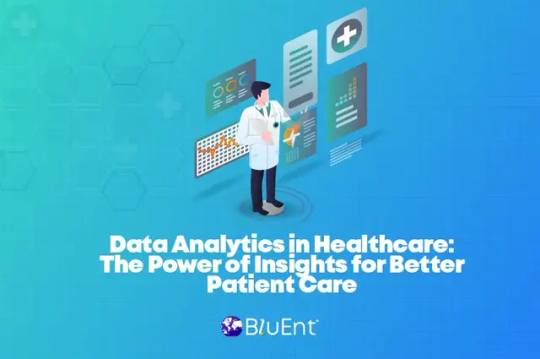#healthcare big data analytics
Link
#market research future#healthcare big data analytics#healthcare big data market#healthcare big data industry
0 notes
Text
In the dynamic world of modern business, data-driven decision-making has become a cornerstone of success. Companies that utilize the power of data analytics achieve a competitive edge by making informed choices based on insights obtained from vast amounts of information.
Among the myriad tools available for data analysis, predictive analytics software development stands out for its ability to unlock business growth by forecasting trends, identifying risks, and enabling proactive strategies.
#Predictive analytics for business growth#predictive analytics dashboard development#predictive analytics#predictive data analytics#predictive business analytics#big data predictive analytics#healthcare predictive analytics#predictive customer analytics#predictive analytics in health insurance#predictive analytics for healthcare#future of predictive analytics
0 notes
Text
#Big Data Analytics in Healthcare#Big Data Analytics in Healthcare market#Big Data Analytics in Healthcare share#Big Data Analytics in Healthcare size#Big Data Analytics in Healthcare growth#Big Data Analytics in Healthcare skills
0 notes
Text
How Does Predictive Analytics in Healthcare Revolutionize Patient Care?

Predictive analytics in healthcare transforms how medical experts use data science services for precise medical diagnosis, patient health monitoring, general medicine and treatment, high-risk disease forecasts, and more.
Not just for patient care, medical specialists and researchers are using predictive AI to predict pandemic-like emergencies.
There is much more to delve into the role of predictive healthcare analytics and its benefits. If you're a healthcare group, a medical health officer, a healthcare researcher, or a chief medical analyst, this blog is a must-read for you.
As per the GlobeNewsWire's report, the worldwide healthcare predictive analytics market will grow at a CAGR of 22.23% to be valued at $30 billion by 2028.
For a long time, the medical community has been trying to organize their tremendous amounts of data and derive value from it for patient care. Now, with predictive analytics, there lies an opportunity to revolutionize the global healthcare industry.
What is Predictive Analytics in Healthcare?
The healthcare and medical industry has vast amounts of data.
From research papers and academic teachings to patient data and lab tests, big data insights and records offer many opportunities for modern computational tools to analyze and derive value.
0 notes
Text
Special Edition: Big Data in Healthcare
(Patreon Exclusive)
Become a member and watch the episode on Patreon!
The relevant blog post is titled The Impact of Big Data on Healthcare.
The blog post titled Big Data: Regulating Privacy and Security in Healthcare discusses this subject further.

View On WordPress
0 notes
Text
The Big Data Analytics in Healthcare Market was valued at 30.6 billion in 2022 and will reach USD 117.70 billion in 2030 growing at a CAGR of 18.34% for the forecast period between 2023 and 2030. In recent years, there has been a continuous increase in the demand for solutions offering effective analytical tools. Both public and private hospitals are seeking ways to leverage big data's capabilities for enhanced decision making, competitive advantage, and improving company performance.
0 notes
Text
Unveiling a Healthcare Breakthrough: Global Healthcare Giant Saves $7.5 Million Annually with Intelligent & Unified Data Management
The pharmaceutical industry thrives on data, which plays a crucial role in every step, from clinical trials to regulatory compliance and drug development. However, amidst the vast amount of data generated daily, valuable insights often get lost in the maze of orphan files and dark data. Shockingly, research shows that 60–85% of unstructured data in shared storage setups remain in the dark.


Join us on their transformative journey, where they saved a staggering $7.5 million annually by reshaping their data landscape. Prepare to be inspired!
Click to read — https://bit.ly/3ISycK8
0 notes
Text
Explore the transformative potential of big data analytics in healthcare from a new economy perspective. This insightful blog delves into the benefits and applications of big data analytics in the healthcare industry, including improved patient outcomes, personalized medicine, predictive analytics, and operational efficiency. Discover how harnessing the power of big data can drive innovation, enhance decision-making, and optimize healthcare delivery. Stay ahead of the curve and unlock the full potential of big data analytics in revolutionizing healthcare.
0 notes
Text

In healthcare, innovation will come from the value of AI solutions and their capacity for processing massive data sets that are far beyond the scope of human ability. To know more, visit @ https://teksun.com/solution/iot-air-conditioner-control-system/
#Artificial Intelligence#Healthcare Innovation#Medical Imaging#Electronic Health Records#Predictive Analytics#Machine Learning#Big Data#Wearable Technology#Healthcare Automation
0 notes
Link
#market research future#healthcare big data analytics#healthcare big data market#healthcare big data industry
0 notes
Text
25 Ways Healthcare Data is Revolutionizing the Healthcare Industry
An exhaustive list for healthcare and healthcareIT colleagues and friends. Happy Reading!
Healthcare data refers to the information collected from various sources in the healthcare system, including medical records, laboratory results, and insurance claims. This data can be used in numerous ways to advance healthcare and improve patient outcomes. From improving patient safety to developing personalized treatment plans, healthcare data is a valuable tool that can help healthcare…

View On WordPress
#big data in healthcare#electronic health records#health data privacy#health data security#health information technology#healthcare AI#Healthcare Analytics#healthcare blockchain#healthcare data#healthcare data ethics#healthcare data governance#healthcare data integration#healthcare data mining#healthcare data storage#healthcare data visualization#healthcare data warehousing#Healthcare Interoperability#healthcare machine learning#medical informatics#patient outcomes#personalized medicine#Population Health Management#predictive analytics in healthcare#telemedicine#wearables in healthcare
1 note
·
View note
Text
#bigdataanalytics#healthcare#academicassignments#healthcareassignmenthelp#assignmentwritingservices#Top10 Examples Of Big Data Analytics In Healthcare - Academic Assignments
0 notes
Text

The field of two-year program data science is growing rapidly, and a PGDM in Big data analytics from Asia Pacific Institute prepares students for this industry.
Companies require Data analysts to manage big data, there is a high demand for skilled professionals in this field. A PGDM in Big data analytics from Asia Pacific Institute of Management offers a two-year program that trains students in various areas of data analytics, including healthcare management, Big data analytic, PGDM in marketing. With an AICTE approval, this program has a good placement record with an average package of 8.11 lakhs, and 80% of participating companies are MNCs.
0 notes
Text
How Hospitals Can Use Data Analytics in Healthcare for Better Outcomes

Data analytics in healthcare is one of the medical industry's driving forces, revolutionizing how patients are cared for. It can even reduce expenses and streamline internal and other medical processes at a corporate level.
The use of healthcare data analytics enables more individualized treatments, better decision-making, and patient well-being. Hospitals leveraging big data analytics and insights are more likely to get quicker and more precise findings to take accurate precautionary actions.
A recent report projected that the healthcare analytics market will reach 85.9 billion by 2027, growing at a CAGR of 25.7%.
Using data analytics, the medical industry can choose between treatments or surgeries and forecast the course of major health occurrences. With this, health experts can initiate long-standing plans based on data-driven reports and analyses that swiftly collect and deliver comprehensive & reliable data.
In this blog, we will give you an overview of big data analytics in healthcare and how it is used to improve outcomes in the healthcare industry.
Healthcare Analytics: Offering Real-Time Information
Data analytics in healthcare examines recent and past medical data to forecast developments and trends, enhance outreach, and control disease transmission.
It also involves the role of predictive analytics in healthcare to enhance the standard of patient care, medical data, diagnostics, company operations, and administration using micro and macro insights.
According to GrandViewResearch's study, healthcare analytics's current market size value is USD 43.1 billion, which will turn into USD 167.0 billion in 2030.
0 notes
Text
#Advanced analytics in healthcare#Predictive Analytics in Healthcare#Healthcare Data Analytics#Big Data in Healthcare#Big Data Analytics in Healthcare
0 notes
Text
Enhancing Immunity - Defending Against Social Engineering Attacks

Social engineering is a form of psychological manipulation used to gain access to confidential information or resources. This tactic is often used by criminals and hackers who use deception, manipulation, and influence tactics to exploit people’s trust in order to gain access to sensitive data in IT operations. Social engineering can be used for malicious purposes such as identity theft or financial fraud, or it can be used for more purposes such as marketing campaigns. In either case, social engineering relies on exploiting human psychology in order to achieve its goals.
Social engineering attacks are becoming more and more common as hackers become increasingly sophisticated. It is important for companies to understand the steps involved in a social engineering attack so that they can take steps to protect themselves from such threats.
Social engineering attacks involve manipulating people into revealing sensitive information or granting access to systems, networks, or physical premises. These attacks typically involve tricking people into giving out confidential information by exploiting their trust and lack of security knowledge. The attacker may also use physical means such as impersonation or tailgating to gain access to restricted areas.
In order to protect against social engineering attacks, it is important for companies to be aware of the steps involved in such an attack. This includes understanding how attackers use psychological tactics, how they exploit human weaknesses, and what measures can be taken to prevent such attacks from occurring.
Social engineering attacks are one of the most common cyber threats that organizations face today. These attacks use psychological manipulation and deception to gain access to sensitive information or resources. They can take many forms, including phishing emails, malicious links, and impersonation scams.
Awareness of Social Engineering Attacks
Validating the identity of the user with whom we are doing business
Checking for the authenticity of the attachments and the email we get in our inbox
Double-checking the content and legitimacy of the offers and discounts which are sent to us
Verifying the email address, domain, and social media profiles carefully when we get a message from the suspect
Preventing Social Engineering Attacks by Improvising IT Network Immunity
Use of Multifactor authentication adds one extra layer of the security
Adaptive authentication plays a key role in safe authentication
Having a strong password policy or password manager will ensure the user passwords are of not compromised easily
Defining the software access policies
Using desktop virtualization software to give you private, encrypted access to the network connection
Read more @ www.gavstech.com/enhancing-it-network-immunity-to-defend-against-social-engineering-attacks/
#ai in cyber defense#ai devops automation service tools#healthcare database software development#mobile app development#optimal clinical software development#digitaltransformationinhealthcareitconsulting#digital transformation in healthcare it consulting#digital transformation solutions#big data and predictive analytics in healthcare#global it services & solutions provider#robotic process automation coe#microsoft cloud solution provider#predictive analytics in healthcare#business process automation in healthcare
0 notes